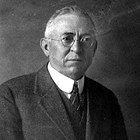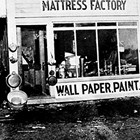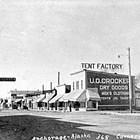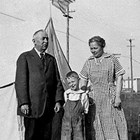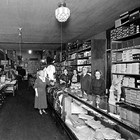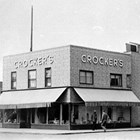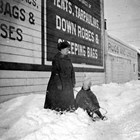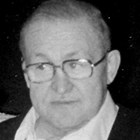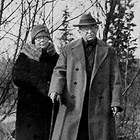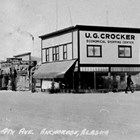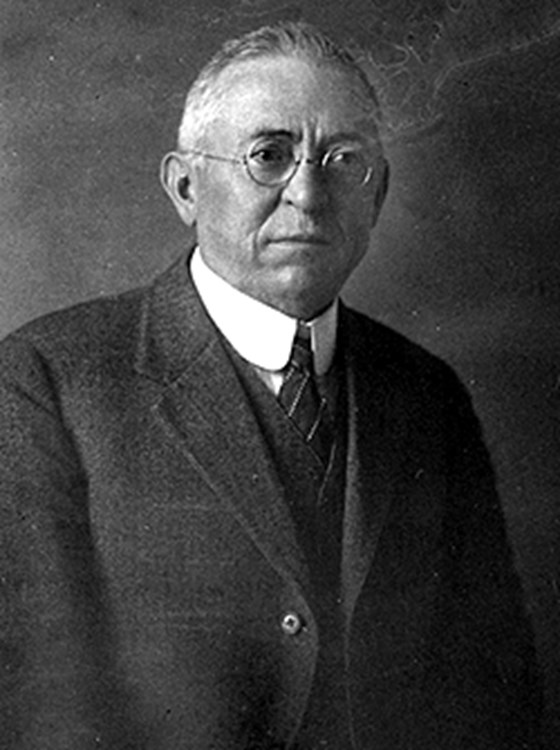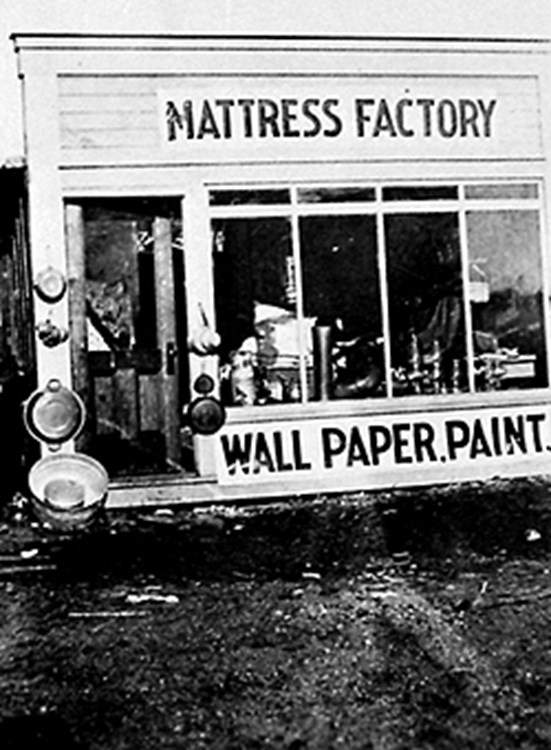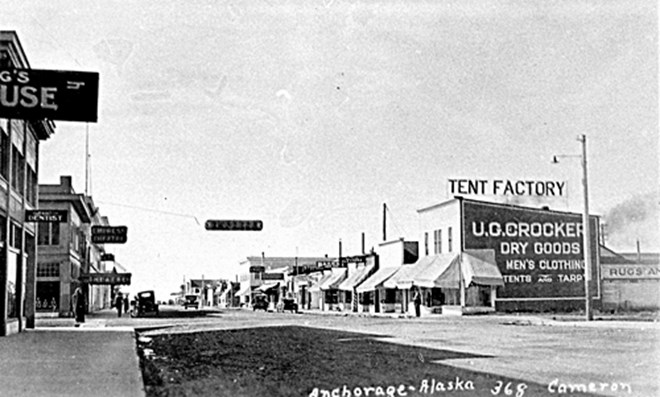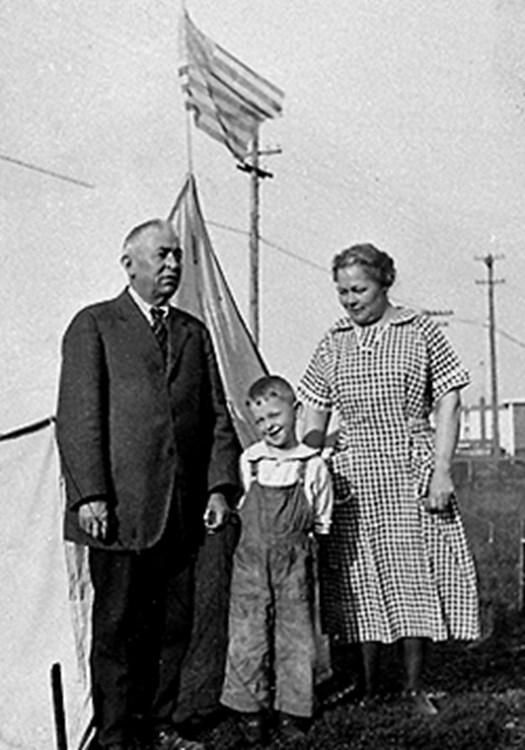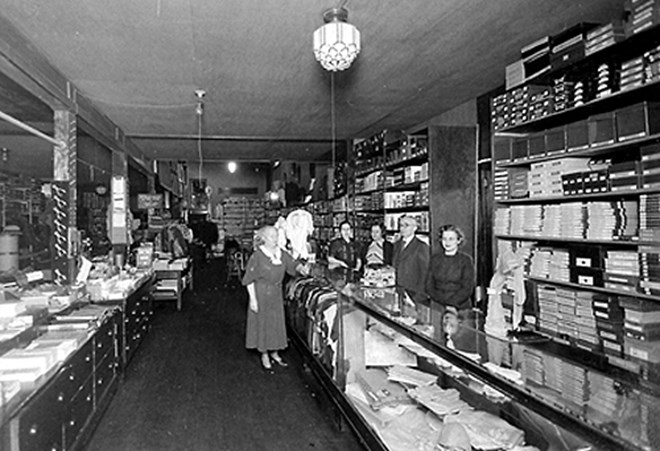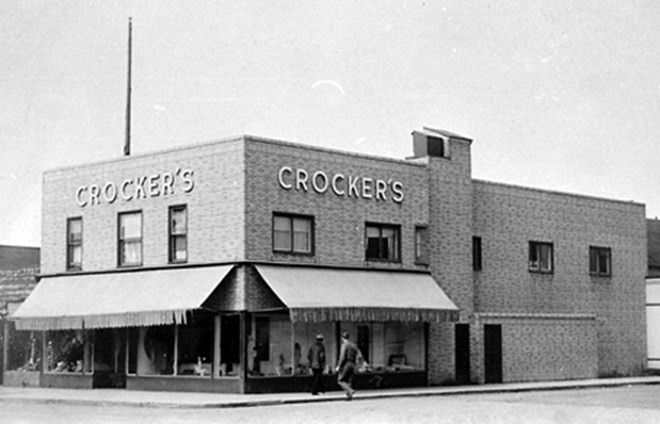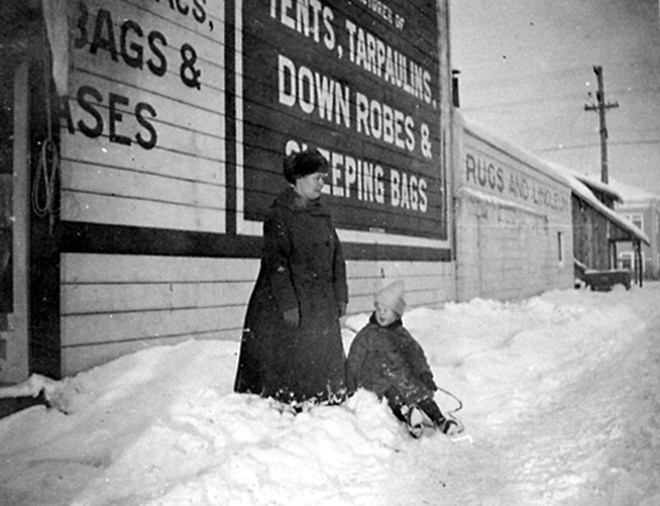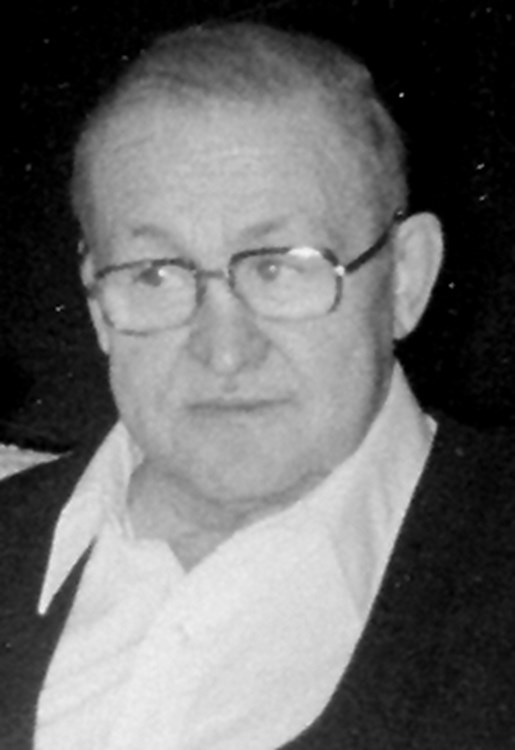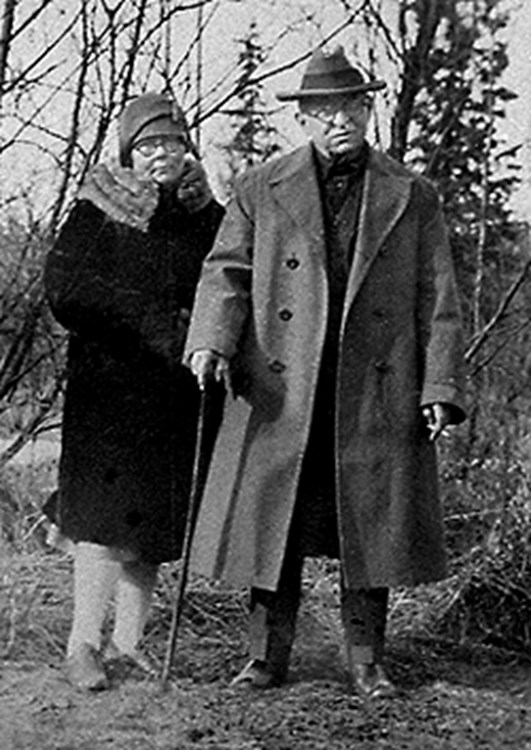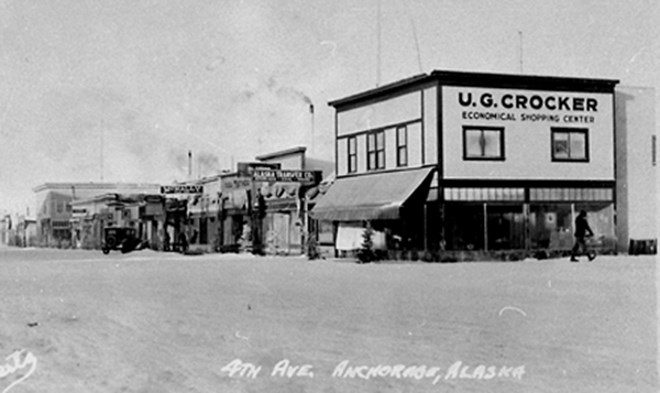Crocker, Ulysses Grant "U.G."
1864-1937 | Miner, Merchant, and Anchorage City Councilman
Ulysses Grant “U.G.” Crocker was one of the founders of Anchorage. Although his contemporaries held him in high esteem as a businessman, he was a prospector at heart and loved to hunt for gold. In an editorial in the Anchorage Daily Times published on June 16, 1937, the day after his death, he was called “a true pioneer of Alaska and one of the builders of Anchorage.” He became attracted to the “embryo city of Anchorage”[1] because of its potential for development and during his twenty-two years of residence was remembered for building his business, Crocker’s Department Store, into a full-scale department store.
Early Years
Ulysses Grant "U.G." Crocker was born in Placer County, California on September 14, 1864, the youngest of eight children of Daniel B. and Fannie Abigail Starks Crocker. He grew up on the family farm, located near Roseville, California.[2] By the time he was sixteen years of age, in 1880, the family had moved to Carson City, Nevada, where his father was a laborer.[3]
Crocker went to Seattle, Washington at the age of eighteen. He was on the Pacific coast in 1898, and came to Alaska to join the Klondike gold rush. Upon his arrival in Dawson, Yukon Territory, he decided to go into business there. Like so many others, he found that all of the good claims had already been staked and immediately returned to Seattle, where he purchased a load of assorted goods. In Dawson, he sold out his inventory and then went to Nome, Alaska running a bakery on a scow as it floated down the Yukon River to the new gold camp. In Nome, he started its bakery and reportedly “made a fortune” before returning to Seattle.[4]
Crocker returned to Alaska and spent two winters in the Koyukuk country, where his mining operations did well. After returning to Seattle for a short stay, his next residence was in Valdez, where he established a store there and in Seward. When the Copper River and Northwestern Railway was being built by the Kennecott Corporation between 1908 and 1911 to take copper ore from Kennicott to Cordova in Prince William Sound, he went there and was hired to work on the project. He then moved to Idaho, where he engaged in farming for two years and then left for Chicago.
Arrival in Anchorage and Business Career (1915-1937)
Crocker returned to Alaska in 1915, and came to Anchorage to open a furniture store.[5] He met and married Ida “Mary” Anderson, who was born in Helsinki, Finland, in 1876, and had come to marry a local homesteader. The Crockers made and repaired tents, awnings, and sleeping bags and their business thrived in the tent city.”[6] They opened their original store on 4th Avenue, between H and I Streets, in 1915. During the first years of his business, he was known particularly as a mattress maker.[7] He later moved from this unpretentious frame building to a new location at 4th Avenue and G Street, across from what is now the Old Historic Anchorage Federal Building (605 West Fourth Avenue, between F and G Streets).
Crocker’s furniture business grew with Anchorage, and he expanded it to meet the market, developing it into one of the earliest department stores. The Crockers built a two-story frame building (701 West Fourth Avenue) on the corner of 4th Avenue and G Street in Anchorage, west of the Lathrop building. He sold furniture and manufactured and sold canvass items, such as awnings, tents, wing covers and fuselage, mattresses, tents, and tarps. On the first floor, toys, jewelry, clothing, and notions were available for sale. Pillows, blankets, and sheets were sold in the basement. Later, they expanded their business to canvas automobile tops and wing fabrics for bush pilots’ airplanes.[8] Crockers became an establishment recognized for its large variety of merchandise, outfitting miners and trappers as well as local customers.[9]
The Crocker family lived in the rear of the second floor of the Crocker Building (701 West Fourth Avenue) and the store occupied the remainder of the structure. Ida "Mary" Crocker was a gourmet cook, and took great pride in entertaining friends. Their son, Eugene, was born in 1918.
Crocker served two two-year terms on the Anchorage City Council, from 1925-1926 and from 1932-1933. He was a member of the Pioneers of Alaska, Igloo 15, Anchorage, and a director of the First National Bank of Anchorage.[10]
On June 6, 1937, Crocker left Anchorage to start on a trip that would lead to his death. Along with his son Eugene and guide Elmer Simco, he embarked on a boat trip up the Koyukuk River, in search of a gold claim that he had discovered thirty years earlier. The previous year, he had sent men to the area to find his claim, but they failed. He then chartered an airplane to make a search, but the country looked different from the air and he could not spot his claim. Undaunted, he built a motorboat to go up the river. He was confident that he would recognize the ground if he approached from the water as he had traveled in this manner when he first discovered it. On June 20, ten miles above Koyukuk Station, while enroute to the upper Koyukuk River, he was at the wheel of his boat, steering the vessel when, without warning, he collapsed from a heart attack and died.[11]
Epilogue
Ida "Mary" Crocker and her son, Eugene, continued to run the department store until she retired. She moved to Seattle, and died there on November 15, 1968. Eugene Crocker married Irma Wahl and they had three children: Linda Gene White, Arlene Mary Bennett, and Eugene Charles.
Ida "Mary" Crocker was survived by her only son, Eugene Crocker, Sr. (1918-1990). Both Ulysses Grant "U.G." and Ida "Mary" Crocker are buried in Anchorage Memorial Park Cemetery.
Endnotes
[1] “A True Pioneer Is Taken By Death [Editorial]," Anchorage Daily Times, June 16, 1937, 2.
[2] Daniel Crocker, Nonpopulation Schedules for California, 1870: Agriculture, in Nonpopulation Census Schedules for California, 1850-1880, Roll 20, Page 3, line 20, Township 1, Placer, California [Bancroft Library, University of California, Berkeley], U.S., Selected Federal Census Nonpopulation Census Schedules, 1850-1880 [database on-line], http://ancestry.com (accessed July 24, 2016).
[3] David B. [Daniel B.] Crocker, U.S. 1880 Census, Carson City, Ormsby County, Nevada, National Archives Microfilm Publication T9, Tenth Census of the United States, 1880, Roll 70, ED 38, page 34D, 1880 United States Federal Census [database on-line], http://ancestry.com (accessed July 24, 2016).
[4] “U.G. Crocker Dies on Koyukuk,” Anchorage Daily Times, June 15, 1937, 1 and 5; and “Ulysses Grant Crocker,” in Ed Ferrell, Biographies of Alaska-Yukon Pioneers, 1850-1950 (Bowie, MD: Heritage Books, Inc., 1994), 79.
[5] “U.G. Crocker Dies on Koyukuk,” Anchorage Daily Times, June 15, 1937, 1 and 5.
[6] Evangeline Atwood, Anchorage: Star of the North (Tulsa, OK: Continental Heritage Press, Inc., 1982), 56.
[7] “A True Pioneer Is Taken By Death [Editorial]," Anchorage Daily Times, June 16, 1937, 2.
[8] Mary Crocker continued the canvas operation after her husband’s death in 1937, and until she passed away in 1968. Evangeline Atwood, Anchorage: Star of the North (Tulsa, OK: Continental Heritage Press, Inc., 1982), 56.
[9] Michael Carberry and Donna Lane, Patterns of the Past: An Inventory of Anchorage’s Historic Resources (Anchorage: Community Planning Department, Municipality of Anchorage, 1986), 78-79.
[10] "History of Mayors and Assembly Members, 1925-1985 [Mayors and Councilmen of the City of Anchorage, 1925-1985]," Clerk’s Office, Municipality of Anchorage, Anchorage, AK; and “U.G. Crocker Rites Take Place at 2 P.M.,” Anchorage Daily Times, June 19, 1937, 7.
[11] "U.G. Crocker Dies on Koyukuk," Anchorage Daily Times, June 15, 1937, 1 and 5; and “A True Pioneer Is Taken By Death [Editorial]", Anchorage Daily Times, June 16, 1937, 2.
Sources
This biographical sketch of Ulysses Grant “U.G.” Crocker is based on an essay which originally appeared in John P. Bagoy’s Legends & Legacies, Anchorage, 1910-1935 (Anchorage: Publications Consultants, 2001), 45. See also the "U.G." Crocker file, Bagoy Family Pioneer Files (2004.11), Box 2, Atwood Resource Center, Anchorage Museum at Rasmuson Center, Anchorage, AK. Photographs courtesy of the Crocker family. Edited by Mina Jacobs, 2012. Edited, revised, and expanded by Bruce Parham, July 24, 2016.
Preferred citation: Bruce Parham, “Crocker, U.G.,” Cook Inlet Historical Society, Legends & Legacies, Anchorage, 1910-1940, http://www.alaskahistory.org.
Major support for Legends & Legacies, Anchorage, 1910-1940, provided by: Anchorage Museum at Rasmuson Center, Atwood Foundation, Cook Inlet Historical Society, and the Rasmuson Foundation. This educational resource is provided by the Cook Inlet Historical Society, a 501 (c) (3) tax-exempt association. Contact us at the Cook Inlet Historical Society, by mail at Cook Inlet Historical Society, Anchorage Museum at Rasmuson Center, 625 C Street, Anchorage, AK 99501 or through the Cook Inlet Historical Society website, www.cookinlethistory.org.
